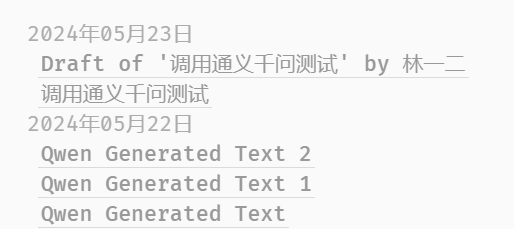When creating Command palette plugin v1.0, I find the referenced “Souk21/TW-commandpalette” plugin has a feature to call actionString (A tiddler of action widgets).
I think actionString + command palette may be a way to trigger AI generation, with context of currentTiddler.
I let GPT-4o generate an example API call to QWEN API
\procedure apikey() sk-xxxxxxxxxxx
\procedure qwenTextGenerate(promptValue)
\procedure completion()
\import [subfilter{$:/core/config/GlobalImportFilter}]
<$action-log msg="In completion"/>
<!-- Success -->
<$list filter="[<status>compare:number:gteq[200]compare:number:lteq[299]]" variable="ignore">
<$action-log msg="Generated text" text={{{ [<data>jsonget[output],[text]trim[]] }}}/>
<!-- Save the generated text -->
<$action-createtiddler $basetitle="$:/temp/TestQwenAPI/result" $overwrite="yes" text={{{ [<data>jsonget[output],[text]trim[]] }}}/>
</$list>
<!-- Failure -->
<$list filter="[<status>compare:number:lt[200]] [<status>compare:number:gt[299]]" variable="ignore">
<$action-log msg="API request failed" status=<<status>> statusText=<<statusText>> error=<<error>>/>
</$list>
\end completion
\procedure request-url()
https://dashscope.aliyuncs.com/api/v1/services/aigc/text-generation/generation
\end request-url
\procedure request-body()
{
"model": "qwen-max",
"input": {
"messages": [
{
"role": "system",
"content": "You are a professional translator, specializing in using AI tools to translate the content I input. Target language: Chinese. Optimization points: grammar correction, conforming to normal Chinese expression, adapting to Chinese culture. Requirement: Try to use the professional terms in the file I uploaded, but if there is a serious conflict in meaning, do not adhere to the translation in the file. Special attention: Maintain the original meaning, optimize language fluency and accuracy. This is content from the game CDDA Cataclysm, ensure it fits a world after a zombie virus outbreak. Only output the translated content, do not provide any explanation."
},
{
"role": "user",
"content": "<<promptValue>>\n\nTranslation:"
}
]
},
"max_tokens": 100,
"temperature": 0.7
}
\end request-body
<$wikify name="url" text=<<request-url>>>
<$wikify name="body" text=<<request-body>>>
<$action-sendmessage
$message="tm-http-request"
url=<<url>>
method="POST"
header-Content-Type="application/json"
header-Authorization=`Bearer $(apikey)$`
body=<<body>>
bind-status="$:/temp/qwen/status"
bind-progress="$:/temp/qwen/progress"
oncompletion=<<completion>>
/>
</$wikify>
</$wikify>
\end qwenTextGenerate
\procedure display-input()
<$edit-text tiddler="$:/temp/TestQwenAPI/prompt" tag="input" placeholder="Please enter the text to translate"/>
<$button>
Translate
<$macrocall $name="qwenTextGenerate" promptValue={{$:/temp/TestQwenAPI/prompt}} />
</$button>
\end display-input
!! Qwen Translation API Call Example
<<display-input>>
<$macrocall $name="qwenTextGenerate" promptValue="Please enter the text to translate" />
!! Result
{{$:/temp/TestQwenAPI/result}}
It is quite long, after several edit and argue with LLM, it finally works.
Just wondering anyone who tried to use this message before for AI?
